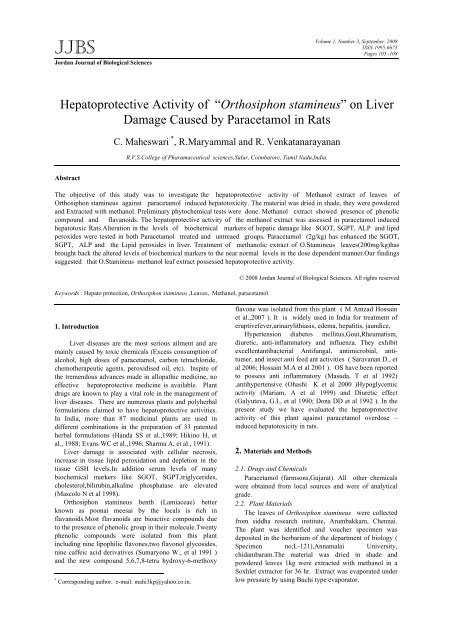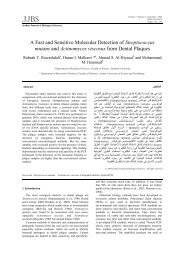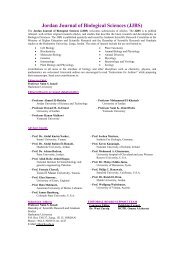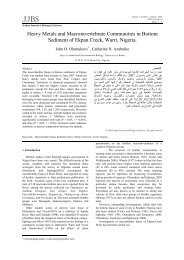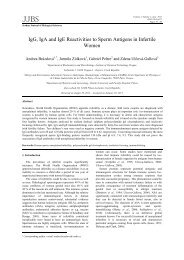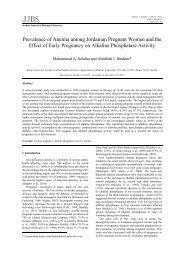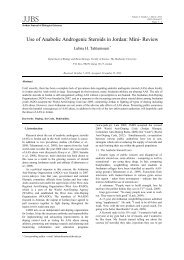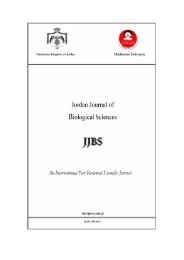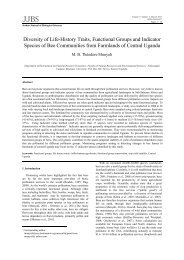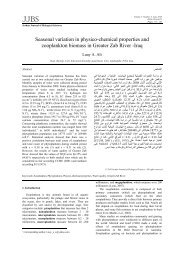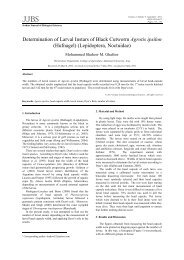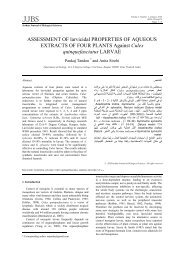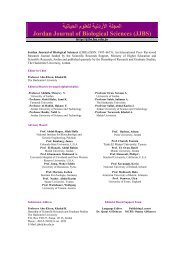Hepatoprotective Activity of ?Orthosiphon stamineus? on Liver ...
Hepatoprotective Activity of ?Orthosiphon stamineus? on Liver ...
Hepatoprotective Activity of ?Orthosiphon stamineus? on Liver ...
Create successful ePaper yourself
Turn your PDF publications into a flip-book with our unique Google optimized e-Paper software.
JJBS<br />
Jordan Journal <str<strong>on</strong>g>of</str<strong>on</strong>g> Biological Sciences<br />
Volume 1, Number 3, September. 2008<br />
ISSN 1995-6673<br />
Pages 105 -108<br />
<str<strong>on</strong>g>Hepatoprotective</str<strong>on</strong>g> <str<strong>on</strong>g>Activity</str<strong>on</strong>g> <str<strong>on</strong>g>of</str<strong>on</strong>g> “<str<strong>on</strong>g>Orthosiph<strong>on</strong></str<strong>on</strong>g> <str<strong>on</strong>g>stamineus</str<strong>on</strong>g>” <strong>on</strong> <strong>Liver</strong><br />
Damage Caused by Paracetamol in Rats<br />
Abstract<br />
C. Maheswari * , R.Maryammal and R. Venkatanarayanan<br />
R.V.S College <str<strong>on</strong>g>of</str<strong>on</strong>g> Pharamaceutical sciences,Sulur, Coimbatore, Tamil Nadu,India.<br />
The objective <str<strong>on</strong>g>of</str<strong>on</strong>g> this study was to investigate the hepatoprotective activity <str<strong>on</strong>g>of</str<strong>on</strong>g> Methanol extract <str<strong>on</strong>g>of</str<strong>on</strong>g> leaves <str<strong>on</strong>g>of</str<strong>on</strong>g><br />
<str<strong>on</strong>g>Orthosiph<strong>on</strong></str<strong>on</strong>g> <str<strong>on</strong>g>stamineus</str<strong>on</strong>g> against paracetamol induced hepatotoxicity. The material was dried in shade, they were powdered<br />
and Extracted with methanol. Preliminary phytochemical tests were d<strong>on</strong>e. Methanol extract showed presence <str<strong>on</strong>g>of</str<strong>on</strong>g> phenolic<br />
compound and flavanoids. The hepatoprotective activity <str<strong>on</strong>g>of</str<strong>on</strong>g> the methanol extract was assessed in paracetamol induced<br />
hepatotoxic Rats.Alterati<strong>on</strong> in the levels <str<strong>on</strong>g>of</str<strong>on</strong>g> biochemical markers <str<strong>on</strong>g>of</str<strong>on</strong>g> hepatic damage like SGOT, SGPT, ALP and lipid<br />
peroxides were tested in both Paracetamol treated and untreaed groups. Paracetamol (2g/kg) has enhanced the SGOT,<br />
SGPT, ALP and the Lipid peroxides in liver. Treatment <str<strong>on</strong>g>of</str<strong>on</strong>g> methanolic extract <str<strong>on</strong>g>of</str<strong>on</strong>g> O.Stamineus leaves(200mg/kg)has<br />
brought back the altered levels <str<strong>on</strong>g>of</str<strong>on</strong>g> biochemical markers to the near normal levels in the dose dependent manner.Our findings<br />
suggested that O.Stamineus methanol leaf extract possessed hepatoprotective activity.<br />
Keywords : Hepato protecti<strong>on</strong>, <str<strong>on</strong>g>Orthosiph<strong>on</strong></str<strong>on</strong>g> <str<strong>on</strong>g>stamineus</str<strong>on</strong>g> ,Leaves, Methanol, paracetamol<br />
1. Introducti<strong>on</strong><br />
* <strong>Liver</strong> diseases are the most serious ailment and are<br />
mainly caused by toxic chemicals (Excess c<strong>on</strong>sumpti<strong>on</strong> <str<strong>on</strong>g>of</str<strong>on</strong>g><br />
alcohol, high doses <str<strong>on</strong>g>of</str<strong>on</strong>g> paracetamol, carb<strong>on</strong> tetrachloride,<br />
chemotherapeutic agents, peroxidised oil, etc). Inspite <str<strong>on</strong>g>of</str<strong>on</strong>g><br />
the tremendous advances made in allopathic medicine, no<br />
effective hepatoprotective medicine is available. Plant<br />
drugs are known to play a vital role in the management <str<strong>on</strong>g>of</str<strong>on</strong>g><br />
liver diseases. There are numerous plants and polyherbal<br />
formulati<strong>on</strong>s claimed to have hepatoprotective activities.<br />
In India, more than 87 medicinal plants are used in<br />
different combinati<strong>on</strong>s in the preparati<strong>on</strong> <str<strong>on</strong>g>of</str<strong>on</strong>g> 33 patented<br />
herbal formulati<strong>on</strong>s (Handa SS et al.,1989; Hikino H, et<br />
al., 1988; Evans WC et al.,1996; Sharma A, et al., 1991).<br />
<strong>Liver</strong> damage is associated with cellular necrosis,<br />
increase in tissue lipid peroxidati<strong>on</strong> and depleti<strong>on</strong> in the<br />
tissue GSH levels.In additi<strong>on</strong> serum levels <str<strong>on</strong>g>of</str<strong>on</strong>g> many<br />
biochemical markers like SGOT, SGPT,triglycerides,<br />
cholesterol,bilirubin,alkaline phosphatase are elevated<br />
(Mascolo N et al 1998).<br />
<str<strong>on</strong>g>Orthosiph<strong>on</strong></str<strong>on</strong>g> <str<strong>on</strong>g>stamineus</str<strong>on</strong>g> benth (Lamiaceae) better<br />
known as po<strong>on</strong>ai meesai by the locals is rich in<br />
flavanoids.Most flavanoids are bioactive compounds due<br />
to the presence <str<strong>on</strong>g>of</str<strong>on</strong>g> phenolic group in their molecule.Twenty<br />
phenolic compounds were isolated from this plant<br />
including nine lipophilic flav<strong>on</strong>es,two flav<strong>on</strong>ol glycosides,<br />
nine caffeic acid derivatives (Sumary<strong>on</strong>o W., et al 1991 )<br />
and the new compound 5,6,7,8-tetra hydroxy-6-methoxy<br />
* Corresp<strong>on</strong>ding author. e-mail: mahi3kp@yahoo.co.in.<br />
© 2008 Jordan Journal <str<strong>on</strong>g>of</str<strong>on</strong>g> Biological Sciences. All rights reserved<br />
flav<strong>on</strong>e was isolated from this plant ( M Amzad Hossain<br />
et al.,2007 ). It is widely used in India for treatment <str<strong>on</strong>g>of</str<strong>on</strong>g><br />
eruptivefever,urinarylithiasis, edema, hepatitis, jaundice,<br />
Hypertensi<strong>on</strong> diabetes mellitus,Gout,Rheumatism,<br />
diuretic, anti-inflammatory and influenza. They exhibit<br />
excellentantibacterial Antifungal, antimicrobial, antitumer,<br />
and insect anti feed ant activities ( Saravanan D., et<br />
al 2006; Hossain M.A et al 2001 ). OS have been reported<br />
to possess anti inflammatory (Masuda, T et al 1992)<br />
,antihypertensive (Ohashi K et al 2000 )Hypoglycemic<br />
activity (Mariam, A et al 1999) and Diuretic effect<br />
(Galyuteva, G.I., et al 1990; D<strong>on</strong>a DD et al 1992 ). In the<br />
present study we have evaluated the hepatoprotective<br />
activity <str<strong>on</strong>g>of</str<strong>on</strong>g> this plant against paracetamol overdose –<br />
induced hepatotoxicity in rats.<br />
2. Materials and Methods<br />
2.1. Drugs and Chemicals<br />
Paracetamol (farms<strong>on</strong>s,Gujarat). All other chemicals<br />
were obtained from local sources and were <str<strong>on</strong>g>of</str<strong>on</strong>g> analytical<br />
grade.<br />
2.2. Plant Materials<br />
The leaves <str<strong>on</strong>g>of</str<strong>on</strong>g> <str<strong>on</strong>g>Orthosiph<strong>on</strong></str<strong>on</strong>g> <str<strong>on</strong>g>stamineus</str<strong>on</strong>g> were collected<br />
from siddha research institute, Arumbakkam, Chennai.<br />
The plant was identified and voucher specimen was<br />
deposited in the herbarium <str<strong>on</strong>g>of</str<strong>on</strong>g> the department <str<strong>on</strong>g>of</str<strong>on</strong>g> biology (<br />
Specimen no;L-121),Annamalai University,<br />
chidambaram.The material was dried in shade and<br />
powdered leaves 1kg were extracted with methanol in a<br />
Soxhlet extractor for 36 hr. Extract was evaporated under<br />
low pressure by using Buchi type evaporator.
106<br />
© 2008 Jordan Journal <str<strong>on</strong>g>of</str<strong>on</strong>g> Biological Sciences. All rights reserved - Volume 1, Number 3 (ISSN 1995-6673)<br />
2.3. Animals<br />
Adult male wistar rats weighing 200-250g were<br />
obtained from Raja Muthiah Medical College, Annamalai<br />
University, Chidambaram, Tamil Nadu. They were<br />
maintained at standard housing c<strong>on</strong>diti<strong>on</strong>s and fed with<br />
commercial diet and provided with water ad libitum during<br />
the experiment. The instituti<strong>on</strong>al animal ethical committee<br />
(Reg.no 160/1999/CPCSEA) permitted the study.<br />
Table 1 Effect <str<strong>on</strong>g>of</str<strong>on</strong>g> O.Stamineus Extract <strong>on</strong> Biochemical Parameters in Rats Subjected to Paracetamol Induced Hepatotoxicity<br />
I (C<strong>on</strong>trol)<br />
Group<br />
II (Paracetamol)<br />
Lipid peroxides<br />
(nmole <str<strong>on</strong>g>of</str<strong>on</strong>g> MDA/mg<br />
protein)<br />
Values are mean ± SEM <str<strong>on</strong>g>of</str<strong>on</strong>g> 6 animals in each groups Group II compared with Group I (P
© 2008 Jordan Journal <str<strong>on</strong>g>of</str<strong>on</strong>g> Biological Sciences. All rights reserved - Volume 1, Number 3 (ISSN 1995-6673)<br />
2.7. Histopathological Examinati<strong>on</strong><br />
Small pieces <str<strong>on</strong>g>of</str<strong>on</strong>g> liver tissue were collected in 10%<br />
formaldehyde soluti<strong>on</strong> for histopathological study. The<br />
pieces <str<strong>on</strong>g>of</str<strong>on</strong>g> liver were processed and embedded in paraffin<br />
wax secti<strong>on</strong>s were made about 4-6μm in thickness. They<br />
were stained with hematoxylin and eosin and<br />
photographed.<br />
2.8. Statistical Analysis<br />
The results were expressed as mean ± SEM <str<strong>on</strong>g>of</str<strong>on</strong>g> six<br />
animals from each group. The statistical analysis were<br />
carried out by <strong>on</strong>e way analysis <str<strong>on</strong>g>of</str<strong>on</strong>g> variance (ANOVA)<br />
P values < 0.05 were c<strong>on</strong>sidered significant.<br />
Figure 3. <strong>Liver</strong> tissue <str<strong>on</strong>g>of</str<strong>on</strong>g> paracetamol + OS extract (200 mg/kg)<br />
treated rats showing normal hepatic cells and central Vein<br />
3. RESULTS<br />
3.1. Paracetamol-Induced Hepatotoxicity<br />
Preliminary phytochemical studies revealed the<br />
presence <str<strong>on</strong>g>of</str<strong>on</strong>g> phenolic compound and flav<strong>on</strong>oids were<br />
noticed in methanolic leaf extract. Table 1 shows that<br />
administrati<strong>on</strong> <str<strong>on</strong>g>of</str<strong>on</strong>g> paracetamol induced 48 hour after<br />
intoxicati<strong>on</strong>, a marked increased in serum SGOT, SGPT,<br />
alkaline phosphatase.<br />
The toxic effect <str<strong>on</strong>g>of</str<strong>on</strong>g> paracetamol was c<strong>on</strong>trolled in the<br />
animals treated with methanol extracts (100mg/kg and 200<br />
mg/kg) by way <str<strong>on</strong>g>of</str<strong>on</strong>g> restorati<strong>on</strong> <str<strong>on</strong>g>of</str<strong>on</strong>g> the levels <str<strong>on</strong>g>of</str<strong>on</strong>g> the liver<br />
functi<strong>on</strong>.<br />
At a dose <str<strong>on</strong>g>of</str<strong>on</strong>g> 100 mg/kg, the effect was <strong>on</strong>ly marginal<br />
whereas at higher dose (200mg/kg) the drug effectively<br />
prevented the paracetamol induced liver damage.<br />
Paracetamol treatment group resulted in an increase in<br />
the lipid peroxide levels in liver homogenates.<br />
Administrati<strong>on</strong> <str<strong>on</strong>g>of</str<strong>on</strong>g> the methanol extract <str<strong>on</strong>g>of</str<strong>on</strong>g> O.<str<strong>on</strong>g>stamineus</str<strong>on</strong>g><br />
leaves prevented the accumulati<strong>on</strong> <str<strong>on</strong>g>of</str<strong>on</strong>g> lipid peroxides. At a<br />
lower dose (100mg/kg) there was a marginal effect in the<br />
lipid peroxide level where as at higher dose (200mg/kg)<br />
the drug effectively prevented paracetamol – induced<br />
elevati<strong>on</strong> <str<strong>on</strong>g>of</str<strong>on</strong>g> lipid peroxides in liver (Table1)<br />
3.2. Histopathology<br />
Histological studies also c<strong>on</strong>firmed the hepatoprotective<br />
effect <str<strong>on</strong>g>of</str<strong>on</strong>g> the methanol extract <str<strong>on</strong>g>of</str<strong>on</strong>g> O.<str<strong>on</strong>g>stamineus</str<strong>on</strong>g>. Paracetamol<br />
treated rat liver secti<strong>on</strong>s showed cloudy swelling and fatty<br />
degenerati<strong>on</strong> <str<strong>on</strong>g>of</str<strong>on</strong>g> hepatocytes, necrosis <str<strong>on</strong>g>of</str<strong>on</strong>g> cells were also<br />
107<br />
seen (Figure 1). The drug treatment (200mg/kg methanol<br />
extract) almost normalized these effects in the<br />
histoarchitecture <str<strong>on</strong>g>of</str<strong>on</strong>g> liver (Figure3).<br />
4. DISCUSSION<br />
Paracetamol is a known antipyretic and an analgesic<br />
which produces hepatic necrosis in high doses.<br />
Paracetamol is normally eliminated mainly as sulfate<br />
and glucur<strong>on</strong>ide. Administrati<strong>on</strong> <str<strong>on</strong>g>of</str<strong>on</strong>g> toxic doses <str<strong>on</strong>g>of</str<strong>on</strong>g><br />
paracetamol the sulfati<strong>on</strong> and glucur<strong>on</strong>idati<strong>on</strong> routes<br />
become saturated and hence, higher percentage <str<strong>on</strong>g>of</str<strong>on</strong>g><br />
paracetamol molecules are oxidized to highly reactive<br />
N-acetyl-p-benzoquinemine by cytochrome-450<br />
enzymes.Semiquin<strong>on</strong>e radicals, obtained by <strong>on</strong>e electr<strong>on</strong><br />
reducti<strong>on</strong> <str<strong>on</strong>g>of</str<strong>on</strong>g> N-acetyl-p-benzoquineimine, can covalently<br />
binds to macromolecules <str<strong>on</strong>g>of</str<strong>on</strong>g> cellular membrane and<br />
increases the lipid peroxidati<strong>on</strong> resulting in the tissue<br />
damage.Higher doses <str<strong>on</strong>g>of</str<strong>on</strong>g> paracetamol and N-acetyl-pbenzoquineimine<br />
can alkylate and oxidise intracellular<br />
GSH, which results in the depleti<strong>on</strong> <str<strong>on</strong>g>of</str<strong>on</strong>g> liver GSH pool<br />
subsequently leads to increased lipid peroxidati<strong>on</strong> and<br />
liver damage (Diadelis R et al 1995). In our experiments<br />
it is observed that the lipid peroxidati<strong>on</strong> levels in the<br />
paracetamol group is increased.This clearly indicates that<br />
there is a significant hepatic damage due to paracetamol<br />
and this is further evident from the fact that there is<br />
elevati<strong>on</strong> in the levels <str<strong>on</strong>g>of</str<strong>on</strong>g> various markers <str<strong>on</strong>g>of</str<strong>on</strong>g> hepati<br />
damage like SGOT, SGPT and ALP. Treatment with<br />
O.<str<strong>on</strong>g>stamineus</str<strong>on</strong>g> leaf extract has decreased the levels <str<strong>on</strong>g>of</str<strong>on</strong>g><br />
lipid peroxidati<strong>on</strong> and the elevated levels <str<strong>on</strong>g>of</str<strong>on</strong>g> above<br />
menti<strong>on</strong>ed biochemical markers to the near normal<br />
levels. It may be c<strong>on</strong>cluded that the hepatoprotective<br />
effect <str<strong>on</strong>g>of</str<strong>on</strong>g> O.<str<strong>on</strong>g>stamineus</str<strong>on</strong>g> leaves is due to the preventi<strong>on</strong> <str<strong>on</strong>g>of</str<strong>on</strong>g> the<br />
depleti<strong>on</strong> in the tissue GSH levels. Literature review<br />
shows that the O.<str<strong>on</strong>g>stamineus</str<strong>on</strong>g> c<strong>on</strong>tains phenolic compound<br />
and flavanoids which are present in the methanol extract.<br />
Therefore there is a possibility that the O.<str<strong>on</strong>g>stamineus</str<strong>on</strong>g> leaf<br />
extract may possess hepatoprotective activity.<br />
ACKNOWLEDGEMENT<br />
The authors are grateful to Dr.R.Manavalan, Head <str<strong>on</strong>g>of</str<strong>on</strong>g><br />
the department <str<strong>on</strong>g>of</str<strong>on</strong>g> pharmacy and Mr.R.SURESHKUMAR,<br />
Assistant pr<str<strong>on</strong>g>of</str<strong>on</strong>g>essor in Horticulture , Annamalai University,<br />
AnnamalaiNagar, Chidambaram for providing all the<br />
necessary facilities to carry out this work.<br />
References<br />
Handa SS, Sharma A, Chakraborty KK. Natural products and<br />
plants as liver protecting drugs. Fitoterapia 1989; 57: 307-51.<br />
Hikino H, Kiso Y. Natural products for liver diseases in Ec<strong>on</strong>omic<br />
and medicinal plant research. Vol 2, Academic press, L<strong>on</strong>d<strong>on</strong>.<br />
1988:39-72.<br />
Evans WC. An overview <str<strong>on</strong>g>of</str<strong>on</strong>g> drugs having anithepatotoxic and oral<br />
hypoglycaemic activities In: Trease and Evans pharmacognsoy,<br />
14 th ed. U.K., W.D. Sanders Company Ltd. 1996.
108<br />
© 2008 Jordan Journal <str<strong>on</strong>g>of</str<strong>on</strong>g> Biological Sciences. All rights reserved - Volume 1, Number 3 (ISSN 1995-6673)<br />
Sharma A, Shing RT, Sehgal V, Handa SS, Antihepatotoxic<br />
activity <str<strong>on</strong>g>of</str<strong>on</strong>g> some plants used in herbal formulati<strong>on</strong>s. Fitoterapia<br />
1991; 62: 131-8.<br />
Masuda, T., Masuda, et al. (1992). Orthosiphol A and B, Novel<br />
diterpenoid inhibitors <str<strong>on</strong>g>of</str<strong>on</strong>g> TPA (12-O-tetradecanoylphorbol – 13 –<br />
acetate) – induced inflammati<strong>on</strong>, from <str<strong>on</strong>g>Orthosiph<strong>on</strong></str<strong>on</strong>g> <str<strong>on</strong>g>stamineus</str<strong>on</strong>g>.<br />
Tetrahedr<strong>on</strong> 48 (33) : 6787 – 6792.<br />
Mariam, A., M.Z. Asmawi, et al. (1999) hypoglycaeic activity <str<strong>on</strong>g>of</str<strong>on</strong>g><br />
the aqueous mextract <str<strong>on</strong>g>of</str<strong>on</strong>g> <str<strong>on</strong>g>Orthosiph<strong>on</strong></str<strong>on</strong>g> <str<strong>on</strong>g>stamineus</str<strong>on</strong>g>. Fitoterapia 67<br />
(5): 465 – 468.<br />
Galyuteva, G.I., N.A. Bens<strong>on</strong>, et al., (1990). Comparative<br />
evaluati<strong>on</strong> <str<strong>on</strong>g>of</str<strong>on</strong>g> the diuretic activity <str<strong>on</strong>g>of</str<strong>on</strong>g> leaves and leaf tissue culture<br />
biomass <str<strong>on</strong>g>of</str<strong>on</strong>g> orthosiph<strong>on</strong> <str<strong>on</strong>g>stamineus</str<strong>on</strong>g> Benth. Rastite ‘Nye Resursy<br />
26(4) ; 559 – 565.<br />
D<strong>on</strong>a DD, Nguyen NH, Doan HK, et al. studies <strong>on</strong> the Individual<br />
and combined Diuretic Effects <str<strong>on</strong>g>of</str<strong>on</strong>g> Four Vietnamese Traditi<strong>on</strong>al<br />
Herbal Remedied (Zea Mays, Imperate cylindrical, plantago major<br />
and orthosiph<strong>on</strong> <str<strong>on</strong>g>stamineus</str<strong>on</strong>g>). J.Ethnopharmacol. 1992; 36 (3) :<br />
225 - 31.<br />
Reitman S, Frankel S.A. Colorimetric method for the<br />
determinati<strong>on</strong> <str<strong>on</strong>g>of</str<strong>on</strong>g> serum glutamic Oxaloacetic and glutamic<br />
pyruvic transaminase. AM J Clin Pathol 1957; 28: 56 – 63.<br />
Bessey OA, Lowery DH, Brock MJ. A method for the rapid<br />
determinati<strong>on</strong> <str<strong>on</strong>g>of</str<strong>on</strong>g> alkaline phosphatase with five cubic meters <str<strong>on</strong>g>of</str<strong>on</strong>g><br />
serum, J. Biol chem. 1964; 164:321 –9.<br />
Ohkawa H, Ohishin N & Yagi K, Anal Biochem, 95 (1979) 351.<br />
Lowry O.Hm Rosebrough N.J Farr A L & Randall R.J, J Biol<br />
Chem, 193 (1951) 265.<br />
Saravanan D., Hossain M.A., Salman Z.,Gam L.H., and Zhari<br />
I.,Chemometrics and Intelligent Laboratory Systems,2006,81,21<br />
Hossain M.A.,Salehuddin S.M., and Tarafdar S.A Pakistan<br />
J.Sci.Ind. Res., 2001,44(4),191<br />
Ohashi K, bohgak T, Shibuya H., Antihypertensive<br />
substances in the leaves Kumis Kucing(orthosiph<strong>on</strong> <str<strong>on</strong>g>stamineus</str<strong>on</strong>g>)<br />
in java island. Yakugaku Zasshi 2000;120(5):474-82<br />
Sumary<strong>on</strong>o W., Proksch P.,Wray V., Witte L., L., Hartmaan T.,<br />
Qulatative and Quantitative analysis <str<strong>on</strong>g>of</str<strong>on</strong>g> the phenolic<br />
c<strong>on</strong>stituents from <str<strong>on</strong>g>Orthosiph<strong>on</strong></str<strong>on</strong>g> aristatus.Planta<br />
medica1991;57:176-180<br />
M Amzad Hossain, S .M. Salehuddin and Zhari Ismail Isolati<strong>on</strong><br />
and Characterizati<strong>on</strong> <str<strong>on</strong>g>of</str<strong>on</strong>g> a new poly hydroxy Flav<strong>on</strong>e from the<br />
leaves <str<strong>on</strong>g>of</str<strong>on</strong>g> <str<strong>on</strong>g>Orthosiph<strong>on</strong></str<strong>on</strong>g> Stamineus Indian<br />
J.Nat.prod.,2007,23(4).3-7<br />
Diadelis R, Jan NM,Commandeur ED,Groot,Nico<br />
PE,Vermeulen.Eur J Pharmacol:Envir<strong>on</strong> Toxicol Pharmacol Sect<br />
1995;293:301<br />
Mascolo N,Sharma R,Jain SC, Capasso F. J Ethnopharmacol<br />
1998;22:211


